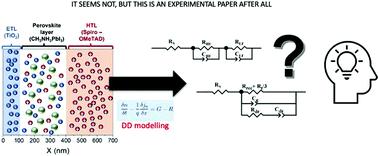当前位置:
X-MOL 学术
›
Phys. Chem. Chem. Phys.
›
论文详情
Our official English website, www.x-mol.net, welcomes your feedback! (Note: you will need to create a separate account there.)
Understanding equivalent circuits in perovskite solar cells. Insights from drift-diffusion simulation
Physical Chemistry Chemical Physics ( IF 3.3 ) Pub Date : 2022-06-17 , DOI: 10.1039/d2cp01338j Antonio J Riquelme 1 , Karen Valadez-Villalobos 1 , Pablo P Boix 2 , Gerko Oskam 1, 3 , Iván Mora-Seró 4 , Juan A Anta 1
Physical Chemistry Chemical Physics ( IF 3.3 ) Pub Date : 2022-06-17 , DOI: 10.1039/d2cp01338j Antonio J Riquelme 1 , Karen Valadez-Villalobos 1 , Pablo P Boix 2 , Gerko Oskam 1, 3 , Iván Mora-Seró 4 , Juan A Anta 1
Affiliation

|
Perovskite solar cells (PSCs) have reached impressively high efficiencies in a short period of time; however, the optoelectronic properties of halide perovskites are surprisingly complex owing to the coupled ionic–electronic charge carrier dynamics. Electrical impedance spectroscopy (EIS) is a widely used characterization tool to elucidate the mechanisms and kinetics governing the performance of PSCs, as well as of many other semiconductor devices. In general, equivalent circuits are used to evaluate EIS results. Oftentimes these are justified via empirical constructions and the real physical meaning of the elements remains disputed. In this perspective, we use drift-diffusion numerical simulations of typical thin-film, planar PSCs to generate impedance spectra avoiding intrinsic experimental difficulties such as instability and low reproducibility. The ionic and electronic properties of the device, such as ion vacancy density, diffusion coefficients, recombination mechanism, etc., can be changed individually in the simulations, so their effects can be directly observed. We evaluate the resulting EIS spectra by comparing two commonly used equivalent circuits with series and parallel connections respectively, which result in two signals with significantly different time constants. Both circuits can fit the EIS spectra and by extracting the values of the elements of one of the circuits, the values of the elements of the other circuit can be unequivocally obtained. Consequently, both can be used to analyse the EIS of a PSC. However, the physical meaning of each element in each circuit could differ. EIS can produce a broad range of physical information. We analyse the physical interpretation of the elements of each circuit and how to correlate the elements of one circuit with the elements of the other in order to have a direct picture of the physical processes occurring in the device.
中文翻译:

了解钙钛矿太阳能电池中的等效电路。漂移扩散模拟的见解
钙钛矿太阳能电池 (PSC) 在短时间内达到了令人印象深刻的高效率;然而,由于耦合的离子-电子电荷载流子动力学,卤化物钙钛矿的光电特性非常复杂。电阻抗谱 (EIS) 是一种广泛使用的表征工具,用于阐明控制 PSC 以及许多其他半导体器件性能的机制和动力学。通常,等效电路用于评估 EIS 结果。通常这些是通过经验结构和元素的真实物理意义仍然存在争议。从这个角度来看,我们使用典型薄膜平面 PSC 的漂移扩散数值模拟来生成阻抗谱,避免了内在的实验困难,例如不稳定性和低再现性。器件的离子和电子特性,如离子空位密度、扩散系数、复合机制等。, 可以在模拟中单独更改,因此可以直接观察到它们的效果。我们通过分别比较两个常用的具有串联和并联连接的等效电路来评估得到的 EIS 光谱,这导致两个信号具有显着不同的时间常数。两个电路都可以拟合 EIS 光谱,通过提取其中一个电路的元素值,可以明确获得另一个电路的元素值。因此,两者都可用于分析 PSC 的 EIS。但是,每个电路中每个元素的物理含义可能不同。EIS 可以产生广泛的物理信息。
更新日期:2022-06-22
中文翻译:

了解钙钛矿太阳能电池中的等效电路。漂移扩散模拟的见解
钙钛矿太阳能电池 (PSC) 在短时间内达到了令人印象深刻的高效率;然而,由于耦合的离子-电子电荷载流子动力学,卤化物钙钛矿的光电特性非常复杂。电阻抗谱 (EIS) 是一种广泛使用的表征工具,用于阐明控制 PSC 以及许多其他半导体器件性能的机制和动力学。通常,等效电路用于评估 EIS 结果。通常这些是通过经验结构和元素的真实物理意义仍然存在争议。从这个角度来看,我们使用典型薄膜平面 PSC 的漂移扩散数值模拟来生成阻抗谱,避免了内在的实验困难,例如不稳定性和低再现性。器件的离子和电子特性,如离子空位密度、扩散系数、复合机制等。, 可以在模拟中单独更改,因此可以直接观察到它们的效果。我们通过分别比较两个常用的具有串联和并联连接的等效电路来评估得到的 EIS 光谱,这导致两个信号具有显着不同的时间常数。两个电路都可以拟合 EIS 光谱,通过提取其中一个电路的元素值,可以明确获得另一个电路的元素值。因此,两者都可用于分析 PSC 的 EIS。但是,每个电路中每个元素的物理含义可能不同。EIS 可以产生广泛的物理信息。



























 京公网安备 11010802027423号
京公网安备 11010802027423号